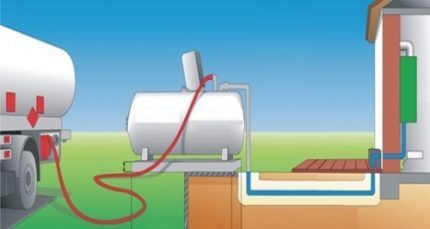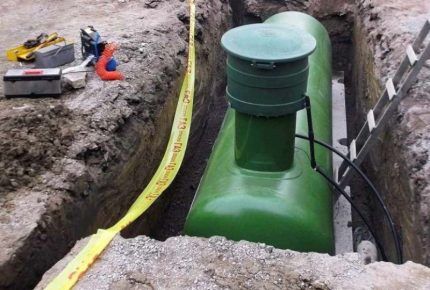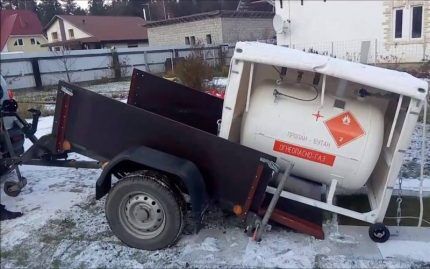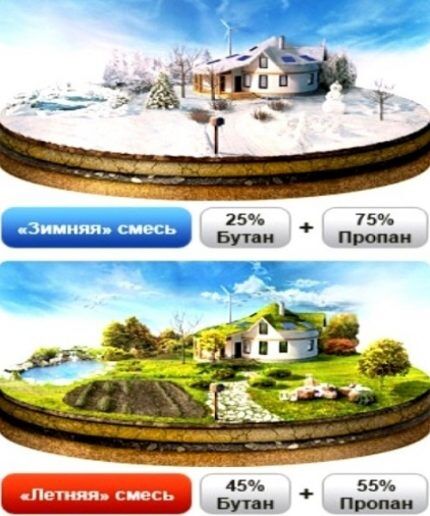Winter and summer gas - what's the difference? What gas is best to use for filling gas tanks?
Autonomous gasification is practical and economical in the use of blue fuel.But for refilling gas tanks, the market offers winter and summer gas, which differ significantly in price.
Agree, each of us wants to save money. But is it worth doing this in the case of gas tank fuel? Next, we will analyze in detail how good cheap LPG is, what its features are and how it will behave in winter.
The content of the article:
Gas fuel brands for gas tanks
The most important thing is to clearly distinguish main and gas tank gas. Both options are used for both heating and cooking on the stove. However, these are fundamentally different gas compositions. In the case of a pipe we are dealing with methane CH4, and a mixture of propane C comes from the gas tank3H8 and butane C4H10. The second type of “blue” fuel will be discussed further.

A propane-butane mixture with a small volume of impurities is poured into the gas tank. Methane is not used in this case, since liquefying it for use in autonomous gas supply is too expensive. To obtain liquefied natural gas, the methane fraction must be cooled to -160 °C. This is done in special factories, costs a lot of money and is used only for transporting LNG over long distances in large volumes.
Liquefying propane with butane is a cheaper operation. To do this, they need to be cooled to much lower temperatures than methane.Plus, LPG can be stored for a long time in a simple gas cylinder or gas holder without any special measures. That is why propane-butane mixture is commonly used in the autonomous gas supply of private households, as well as as fuel for cars.
GOST regulates the use of LPG in the form of:
- PT – technical propane;
- BT – technical butane;
- SPBT – mixtures of technical propane and butane.
The use of these brands in each specific case depends on climatic conditions and the type of gas tank.

BBF is a cheap and low-quality gas with condensate. When it is burned, approximately 10% less heat is released than when using conventional SPBT. It is quite acceptable to pump such fuel into a gas tank and burn it in boilers. However, its use does not have the best effect on the service life of gas equipment, significantly reducing it.
The difference between winter and summer LPG
The mixture of propane and butane in the gaseous state is well mixed with air, which guarantees its uniform combustion and complete combustion. At the same time, GOST provides for a floating ratio of shares of C3H8 and C4H10 in SUG. This is where liquefied gas is divided into summer and winter grades.

The transition of LPG from liquid to steam occurs inside the gas tank. Moreover, if butane at normal pressure is capable of transitioning from liquid to gas at temperatures only up to -0.5 °C, then propane is up to -42 °C.If in liquefied form this or that fuel cools below these indicators, then its transition to the vapor phase will be impossible.
When it’s cold outside at minus 10–20 °C, butane will remain in the form of a liquid. As a result, it will become unsuitable for use in a gas heating boiler or heating water for domestic hot water. The less there is in the gas tank in winter, the better.
In “winter” gas the share of propane reaches 80%, while in “summer” gas it is only about 50%. Butane is much cheaper, so they try to add as much of it to LPG as possible. However, it is also difficult to do without the propane component.
Propane is responsible for the pressure in the system and the stability of the liquid/vapor phase transition. If you fill a “summer” version of LPG into a gas tank for the winter, then at some point the evaporation of the liquefied mixture will stop. As a result, the boiler will be left without fuel and the house without heat.

The basic difference between “summer” and “winter” brands of gas tank gas is the ratio of propane and butane in LPG. The more of the first, the better at any time of the year. However, as the propane share increases, the price of fuel also increases.
If the gas tank is not buried in the ground in accordance with the requirements of SNiPs, and in winter the air temperature drops below zero, then the “summer” LPG mixture in it will definitely stop going into the vapor phase. And then, at the most inopportune moment, the propane will completely evaporate and be used up, and the butane will never become a gas.
Which option is better to choose?
The more butane there is in LPG, the cheaper the liquefied gas for the gas holder.But the efficiency and stability of gas tank equipment directly depends on the more expensive propane contained in the propane-butane mixture. Cheapness is not always good. Wanting to save on fuel, you can find yourself without heating at all in cold weather.

In the case of a gas tank buried below the freezing level, the situation is not so clear. In a warm region, the heat of the earth is usually more than enough to ensure high-quality evaporation of butane even during short-term frosts down to -15 ° C. As a result, there is no point in spending money on an expensive winter version of LPG.
In addition, 50% propane is a good reserve in case of short frosts. In cold weather it will be wasted, and when it warms up, butane will go back into the boiler. This will not create any problems for gas equipment.
However, if a house with a gas holder is located in a cold or very cold climate area, then using fuel with a high propane content cannot be avoided. In such a region, it is better to fill the gas tank in advance with gas intended specifically for winter in the fall. You shouldn't save money here, otherwise you'll end up freezing.
We also recommend that you familiarize yourself with the rules for installing a gas tank on the site. More details - go link.
Features of refueling and rebooting
According to the standards, the gas tank is not fully filled with liquefied gas, but 85%. The remaining 15% is needed for the liquid/vapor phase transition and creating pressure inside the container.If you fill the tank during the year only with a summer mixture, then in winter the butane in the form of a liquid will accumulate in it to capacity. Then it will simply be impossible to add new fuel with propane, and the existing one will not be able to be used for its intended purpose.

The gas holder getting stuck is a serious problem. To pump out the resulting “condensate”, you will have to call gas workers. At the same time, they will take a lot of money for pumping, and then they will dilute the pumped out butane with propane and pour it back into someone’s gas tank. For the supplier there is double gain, and for the owner of the autonomous gas supply system there are only one cost. It is better to avoid such a situation in the first place.
To avoid tangling, one of three methods is used:
- By winter in the fall, “winter” LPG is poured into the gas tank.
- A special evaporator is installed to force the conversion of liquefied butane into gas.
- The outside of the gas holder is wrapped with a heating cable.
The first method is most often used. But the second two should not be excluded either. The operation of the evaporator and heating cable costs electricity. But if such equipment is installed and used, then you can safely order cheap “summer” gas for the winter.
How not to undercut when buying gas?
The difference in price between summer and winter gas is about 30–40%. It is sold cheapest in the spring, and most expensive in the fall. And of course you want to save money here, especially if the gas tank is spacious. However, if LPG is offered at a cost per liter much lower than the market in a particular region, then you should seriously think about it.
It is impossible to clearly indicate which gas is best to fill into a gas tank for the winter; the final decision depends on:
- type of installed container;
- climate of the region;
- presence/absence of additional equipment.
In some situations, it is more profitable to install a forced evaporator for butane and purchase cheap summer gas, while in others, it is more profitable to make a choice exclusively in favor of winter LPG. For each specific case, cost calculations must be done individually. Moreover, the price of liquefied propane varies in each region.

The cost of refilling a gas tank depends on:
- container fullness;
- remoteness of the settlement;
- seasonality and type of gas (summer or winter);
- the volume of actual injection and the dimensions of the barrel of the ordered gas carrier.
If you come across a supplier on the market with a greatly reduced price, then you should once again think about how high-quality his gas is. On the one hand, he is able to substitute summer LPG instead of winter, and on the other hand, he can completely fill the gas tank with a low-quality mixture with condensate and impurities.
You should buy fuel for a gas holder only from time-tested sellers. If there are problems, replacing the liquefied gas tank will cost a tidy sum. Excessive savings on fuel are potential and often inevitable costs for repairing gas equipment.
Conclusions and useful video on the topic
Recommendations for refilling the minigas holder:
The process of pumping gas out of a gas tank for its repair:
How people cheat when filling a gas tank:
In summer, winter gas will burn without any problems.But the use of summer LPG in winter is not always possible. To avoid cold weather with low pressure in the gas holder due to slow vaporization, it is best to fill it in the fall with liquefied fuel with a high propane content. But if the region is warm or special equipment is installed, then it is quite acceptable to fill the container with a cheap summer propane-butane mixture all year round.
Leave your comments, ask questions, share your experience and participate in the discussion of this material. The communication block is located under the article.




I would like to refill the gas tank only once a year, in the spring. The capacity allows it, but I haven’t fully figured out these problems with winter and summer brands. Is it possible to overpay this 30%, fill up with a winter version and use gas all year round?
If the cost does not bother you, then a winter mixture with a high propane content can be used in the summer. The only limitation is that the cylinder must not be heated to 50°C, otherwise the pressure in it will rise to 17 atm, and this is dangerous. Observe safety precautions, do not store the cylinder in the open sun and everything will be fine.
Hello. What do gas workers answer directly to such questions? Look, “summer” gas flows in a ratio of 50:50-60-40 (propane-butane), and in summer it is 75:25-80:20. The best evaporation temperature for butane is positive, while for propane it is negative.
At room, stable temperature, the pressure above liquid propane is approximately 9 atm, while for butane it is 2 atm.When heated to 50 degrees Celsius, the pressure in a propane cylinder can increase to 17 atmospheres, which is not safe. However, our climate usually does not reach such temperatures, and the cylinders can hold even more pressure. So, yes, you can leave winter gas for the summer, as long as the temperature is controlled.
But, again, the standards guarantee a shelf life of liquefied gas of 3-6 months, which depends on the quality of the gas and GOST. If it is 3 months and you adhere to these rules (although they are simply guaranteed, in fact, longer), then you will still have to change the gas.
I have a question: is it possible to use summer gas for MKDs? And then I noticed that the water in our house began to heat up poorly. Hot water is obtained through a water heater. (columns). I have a suspicion that since summer gas is cheaper, the resource company does not use winter gas at all. Due to this, they get a good profit, because the summer one is cheaper. Am I right or wrong? If yes, then I will find out with them. Sincerely, Rita Nikolaevna. I would be grateful if you answer.